Simulations and Projections of Winter Sea Ice in the Barents Sea by CMIP6 Climate Models※
2023-12-26RongrongPANQiSHUZhenyaSONGShizhuWANGYanHEandFangliQIAO
Rongrong PAN, Qi SHU*, Zhenya SONG, Shizhu WANG, Yan HE, and Fangli QIAO
1First Institute of Oceanography, and Key Laboratory of Marine Science and Numerical Modeling,Ministry of Natural Resources, Qingdao 266061, China
2Shandong Key Laboratory of Marine Science and Numerical Modeling, Qingdao 266061, China
ABSTRACT Dramatic changes in the sea ice characteristics in the Barents Sea have potential consequences for the weather and climate systems of mid-latitude continents, Arctic ecosystems, and fisheries, as well as Arctic maritime navigation.Simulations and projections of winter sea ice in the Barents Sea based on the latest 41 climate models from the Coupled Model Intercomparison Project Phase 6 (CMIP6) are investigated in this study.Results show that most CMIP6 models overestimate winter sea ice in the Barents Sea and underestimate its decreasing trend.The discrepancy is mainly attributed to the simulation bias towards an overly weak ocean heat transport through the Barents Sea Opening and the underestimation of its increasing trend.The methods of observation-based model selection and emergent constraint were used to project future winter sea ice changes in the Barents Sea.Projections indicate that sea ice in the Barents Sea will continue to decline in a warming climate and that a winter ice-free Barents Sea will occur for the first time during 2042–2089 under the Shared Socioeconomic Pathway 585 (SSP5-8.5).Even in the observation-based selected models, the sensitivity of winter sea ice in the Barents Sea to global warming is weaker than observed, indicating that a winter ice-free Barents Sea might occur earlier than projected by the CMIP6 simulations.
Key words: Arctic sea ice, Barents Sea, ocean heat transport, sea ice projection, CMIP6
1.Introduction
The retreat of Arctic sea ice is one of the most dramatic consequences of global warming and exerts strong local and remote impacts on the climate, biosphere, and society(IPCC, 2019).In recent decades, the coverage of Arctic sea ice has dramatically changed, with a negative trend of sea ice extent (SIE) in all months (Stroeve and Notz, 2018).Since 1980, sea ice thickness in the central Arctic has also decreased by 1.5–2.0 m (Lindsay and Schweiger, 2015;Kwok, 2018), and total Arctic sea ice volume has decreased substantially, at a rate of approximately 3000 km3(10 yr)–1(Schweiger et al., 2019).The reduction in Arctic sea ice is substantially attributable to the retreat of the SIE in the Barents Sea (Onarheim et al., 2015; Li et al., 2017).The Barents Sea is located at the doorstep of the Arctic Ocean and is divided into two distinct climatic regions: the north with a cold harsh Arctic climate and an ice-associated ecosystem,and the south with a less severe Atlantic climate with lucrative fisheries (Lind et al., 2018).The recent retreat in Arctic winter sea ice has been most pronounced in the Barents Sea(Årthun et al., 2012).Despite its relatively small area within the Arctic Ocean (14%), the Barents Sea accounts for approximately one-quarter of the observed loss of Arctic sea ice in winter, with a loss of ice area of approximately 450 000 km2(47%) between 1979 and 2018 (Onarheim and Årthun,2017; Onarheim et al., 2018; Stroeve and Notz, 2018).
Sea ice decline in the Barents Sea potentially affects the climate and weather of mid-latitude continents in the Northern Hemisphere (Liptak and Strong, 2014; Sorokina et al.,2016), as well as Arctic ecosystems and fisheries (Dalpadado et al., 2014).Although debate continues regarding the impact of sea ice decline in the Barents Sea on the climate and weather of mid-latitude continents (Luo et al., 2018;Ogawa et al., 2018; Mori et al., 2019; Koenigk and Fuentes-Franco, 2019; Blackport and Screen, 2020; Zappa et al.,2021), its potential effects should not be ignored.Sea ice decline in the Barents Sea is also seriously affecting the survival of marine fish and the productivity of phytoplankton(Hop and Gjøsæter, 2013; Dalpadado et al., 2014).Additionally, the location of the sea ice edge in the Barents Sea affects shipping opportunities and economic development.Therefore, it is of great interest to examine how sea ice in the Barents Sea might change in the future.
Climate models are widely used in projections of future climate.However, sea ice simulations and projections by climate models have large biases and uncertainty.For example,small deviations in the parameters of oceanic or atmospheric models can lead to a large spread in the simulation results,including SIE, ice thickness, or sea ice drift rate (Arzel et al.,2006; Turner et al., 2013).The Coupled Model Intercomparison Project Phase 3 (CMIP3) models produce considerable variation in terms of regional sea ice variability, and their predictions of sea ice in the Barents Sea are particularly variable(Arzel et al., 2006).This might reflect the fact that the Barents Sea is strongly influenced by oceanic and atmospheric variations (Kay et al., 2011; Behrens et al., 2012).In most Coupled Model Intercomparison Project Phase 5 (CMIP5) models,climatic features and the general decreasing trend of Arctic sea ice are well represented (Shu et al., 2015), however, the Arctic sea ice concentration (SIC) in March suggests a much weaker downward trend in regions where the observed declines are most pronounced, such as the Barents Sea (Li et al., 2017).Large differences in the simulation of Arctic sea ice by each climate model also exist in the Coupled Model Intercomparison Project Phase 6 (CMIP6) models(Long et al., 2021).However, the performance of each of the CMIP6 models in terms of their simulation of sea ice and its future change in the Barents Sea remains unclear.
This study investigates the simulations and projections of winter sea ice in the Barents Sea based on the output of historical and Shared Socioeconomic Pathway 245 (SSP2-4.5)and 585 (SSP5-8.5) scenario simulations from the latest 41 climate models from CMIP6.The remainder of the paper is organized as follows.The data and methodology used in the study are introduced in section 2.Section 3 presents the results, and section 4 provides discussions and conclusions.
2.Data and methodology
The data used in this study were mainly obtained from the CMIP6 archive.All available ensembles of the 41 CMIP6 coupled models that provide sea ice concentration from both SSP2-4.5 and SSP5-8.5 experiments were used(Table 1).Simulations for the period 1950–2014 were from historical experiments.Future projections were driven by external forcing under the SSP2-4.5 and SSP5-8.5 scenarios,which represent medium and high emission pathways with effective radiative forcings of 4.5 and 8.5 W m–2in 2100,respectively (O'Neill et al., 2016; Riahi et al., 2017).To investigate the influence of model resolution on sea ice simulation in the Barents Sea, the simulations of eight high-resolution coupled models from the CMIP6 High Resolution Model Intercomparison Project (HighResMIP) (Haarsma et al.,2016) (Table 2) were also used in this study.
To assess and quantify the variability and trends of sea ice in the Barents Sea during winter, the satellite-derived SIC from 1980 to 2020 was used, which was produced from brightness temperature data processed at the NASA Goddard Space Flight Center and the National Snow and Ice Data Center (Cavalieri et al., 1996; Meier et al., 2013).The Goddard Institute for Space Studies surface air temperature (SAT)dataset (Hansen et al., 2010; Lenssen et al., 2019) was also used in this study to investigate the sensitivity of sea ice to global warming.
We mainly focused on winter (November–April) sea ice simulations and projections in the Barents Sea (area defined by the blue box in Fig.1a) because the Barents Sea is nearly ice-free in summer.The SIE in the Barents Sea,which is mainly used to evaluate the models and project future sea ice changes, was calculated as the cumulative area of all grid cells that had a monthly average SIC >15%(Onarheim and Årthun, 2017).To project when the Barents Sea might become close to being ice-free in winter, we defined the ice-free condition as 10% of the 1980–1982 average winter SIE (0.08 × 106km2) referencing the method of Onarheim and Årthun (2017).
The ocean heat transport (OHT) through the Barents Sea Opening (BSO; red section in Fig.1a) was used to investigate the reason for the bias of simulated sea ice in the Barents Sea.It was calculated using monthly seawater potential temperature and ocean velocity (Shu et al., 2022):
where ρois the density of seawater,cpis the specific heat capacity of seawater,vis the velocity of the ocean perpendicular to the section of the BSO,Tis the potential temperature in the BSO section,Trefis a reference temperature(here, set to 0°C),His water depth, and λ is the distance along the gateway transect.
Correlation analysis was used to study the relationship between OHT through the BSO and sea ice extent in the Bar-ents Sea and the relationship between the initial state of sea ice and its future changes.The correlation coefficient used in this paper is Spearman’s rho, and the p-value is computed using large-sample approximations.If the p-value is less than 0.05, the correlation is considered significant.
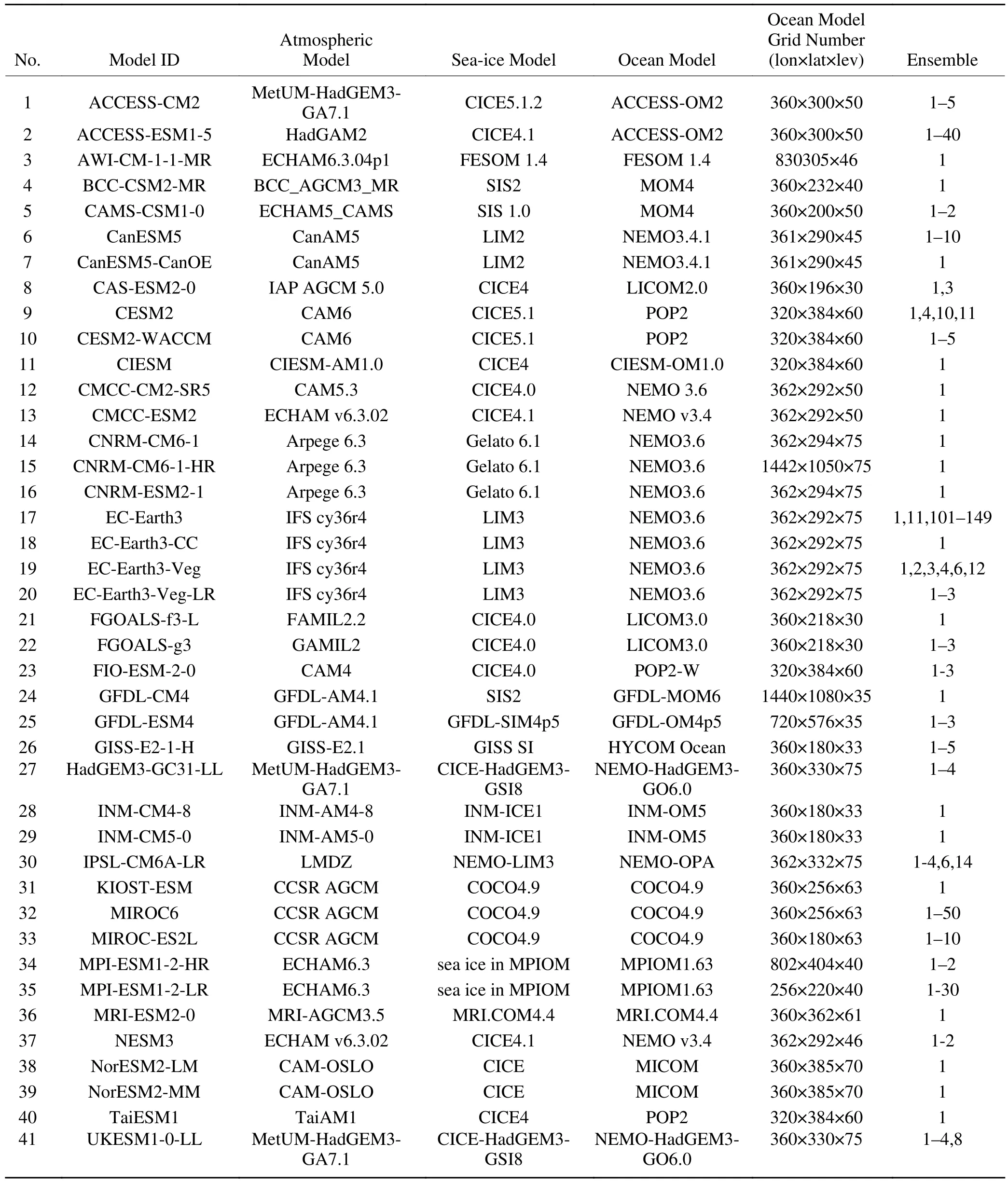
Table 1.Details of the 41 CMIP6 climate models used in this study.
3.Results
3.1.Historical simulation evaluations
To project future changes in the sea ice of the BarentsSea, we first evaluated historical simulations by the CMIP6 models.Based on satellite observations, the historical climatological state indicates that sea ice in the Barents Sea in winter(November–April) is mainly located in northern areas, with the sea ice edge located at 75°N, 15°–55°E (Fig.1a).However, the ratio of CMIP6 models with SIC values exceeding 15% of the climatological mean SIC indicates that most CMIP6 models overestimate the climatology of winter sea ice in the Barents Sea (Fig.1b).The satellite-observed winter SIE in the Barents Sea during 1980–2014 is 0.63 ± 0.08 (0.5 standard deviation of monthly SIE) × 106km2, whereas the CMIP6 multimodel mean result is 0.77 ± 0.03 (0.5 standard deviation of all simulated climatological SIE) × 106km2(Fig.1c).Simulated SIE in most of the CMIP6 climate models is larger than observed in the Barents Sea (Fig.1c).The climatological sea ice edge of each model, shown in Fig.2, also indicates that most of the CMIP6 models overestimate winter sea ice coverage in the Barents Sea.

Table 2.Details of the eight HighResMIP CMIP6 models used in this study.
The discrepancy between climate model simulations and observations can be caused by many factors, such as model errors, internal variability, and the uncertainty of external forcing.One standard deviation of detrended monthly winter SIE can largely represent the amplitude of internal variability of winter SIE, which was 0.98 × 105km2during 1980–2014 based on satellite observations, representing approximately 15% of the climatological SIE.Figure 1d shows that the amplitude of internal variability of SIE can be reproduced by CMIP6 climate models with a multimodel mean of 1.04 ×105km2.Although the amplitude bias of simulated internal variability is small, internal variability will also cause the discrepancy in both climatology and the trend of SIE between models and observations, since the phases of internal variability in climate model simulations without data assimilation are commonly different from the observations.The discrepancy related to this factor is not a model error.
Observations show that winter SIC in the Barents Sea decreased significantly during 1980–2014, with the greatest decrease of 15% (10 yr)–1(Fig.2).However, 70% of the CMIP6 models underestimate the decreasing trend in SIC in the Barents Sea during winter.Figure 2 also shows that the locations with the greatest trend of SIC change in CMIP6 models are different and that several models (CIESM,CNRM-CM6-1, and INM-CM4-8) show positive trends.This may be related to the large natural internal variability of the Barents Sea climate since obvious multidecadal and decadal oscillations in the Barents Sea have been reported(Yashayaev and Seidov, 2015; de la Vega et al., 2022).
The wolf ran as fast as he could, taking the shortest path, and the little girl took a roundabout way, entertaining herself by gathering2 nuts, running after butterflies, and gathering bouquets3 of little flowers. It was not long before the wolf arrived at the old woman s house. He knocked at the door: tap, tap.
Figure 3a shows that the CMIP6 multimodel mean result underestimates the downward trend of SIE in winter in the Barents Sea.The observed trend during 1980–2014 is-1.11 ± 0.34 (95% confidence level) × 105km2(10 yr)–1,and the CMIP6 multimodel mean result is -0.61±0.04 (95%confidence level) × 105km2(10 yr)–1, which falls outside the observed confidence interval.The observed trend of winter SIE in the Barents Sea is approximately twice that of the CMIP6 multimodel mean result.
The above evaluations indicate that the main common problems in the simulation of winter sea ice in the Barents Sea by the CMIP6 models are the overestimation of SIE and the underestimation of its decreasing trend.Investigating the reasons for such common problems is important for model improvement.Figure 3b shows that the winter SIE in the Barents Sea simulated by the CMIP6 models has a significant negative correlation with the strength of OHT through the BSO (rho=-0.67, p<0.01).Warm Atlantic Water enters the Arctic Ocean mainly through two channels: one is the Fram Strait within which water flows directly into the Arctic Ocean basin area, and the other is the BSO through which water flows into the Barents and Kara seas (Polyakov et al.,2013).The effects of Atlantic Water heat transport through the BSO on winter sea ice coverage in the Barents Sea have been investigated by several studies (Årthun et al., 2012; Docquier et al., 2021; Wang et al., 2020).The stronger the OHT through the BSO, the greater the net upward surface heat flux released into the atmosphere from the Barents Sea in winter, which results in warming the surface air and reducing sea ice formation in winter.This can explain the significant correlations between the biases of SIE in the Barents Sea and the strength of OHT through the BSO in the CMIP6 models.Based on observations, the net OHT through the BSO is estimated to be larger than 70 TW (Smedsrud et al., 2010);however, this is underestimated by most CMIP6 climate models (Fig.3b).Therefore, the weaker simulated OHT through the BSO should be the main reason for the overestimation of SIE by most CMIP6 climate models.Docquier et al.(2019) found that climate models that incorporate an ocean model with finer resolution generally drive stronger Atlantic OHT and produce less sea ice in the Arctic.Therefore,improving the horizontal resolution of ocean component models could reduce the common problem of overestimation of winter SIE in the Barents Sea by climate models.
Li et al.(2017) also reported the common bias of an underestimated SIE trend in the Barents Sea by CMIP5 models.Therefore, the problem of the common bias was not resolved by the transition from CMIP5 to CMIP6.They found that a negative trend of simulated sea ice in the Barents Sea is correlated with a positive trend of OHT through the BSO in coupled models in a warming climate (Li et al.,2017), which indicates that this bias is mainly caused by the weaker positive trend in the simulated OHT through the BSO in coupled models.
3.2.SIE projections
This study uses two methods to project the future sea ice change in the Barents Sea.The first method involves the conventional model selection based on historical observations to remove models with a large discrepancy between simulations and observations.The second method incorporates the emergent constraint method based on the significant relationship between the projections and the historical simulations in climate models (Liu et al., 2013).
Figures 1c and 3b show that CMIP6 climate models have large intermodel spread in terms of Barents Sea SIE simulations.Therefore, if only a single model is used for future projection, the projection uncertainty could be large.Calculating the multimodel mean is a useful approach for reducing projection uncertainty.Considering the common bias of SIE overestimation in the CMIP6 climate models, observationbased model selection is helpful before producing projections using the multimodel mean.
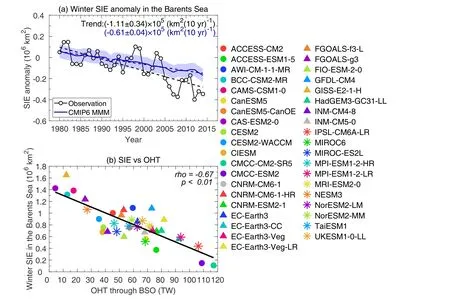
Fig.3.(a) Winter sea ice extent (SIE) anomaly during 1980–2014 (relative to 1980–1999) in the Barents Sea.Blue shading in (a) is one standard deviation of the CMIP6 models.The black and blue dashed lines in (a)are the linear trends of the observations and the CMIP6 multimodel mean (MMM), respectively.(b)Relationship between the climatological mean SIE during 1980–2014 in the Barents Sea in winter and the climatological mean of the annual mean ocean heat transport (OHT) through the Barents Sea Opening (BSO).The black solid line in (b) is an ordinary least squares linear fitting line.
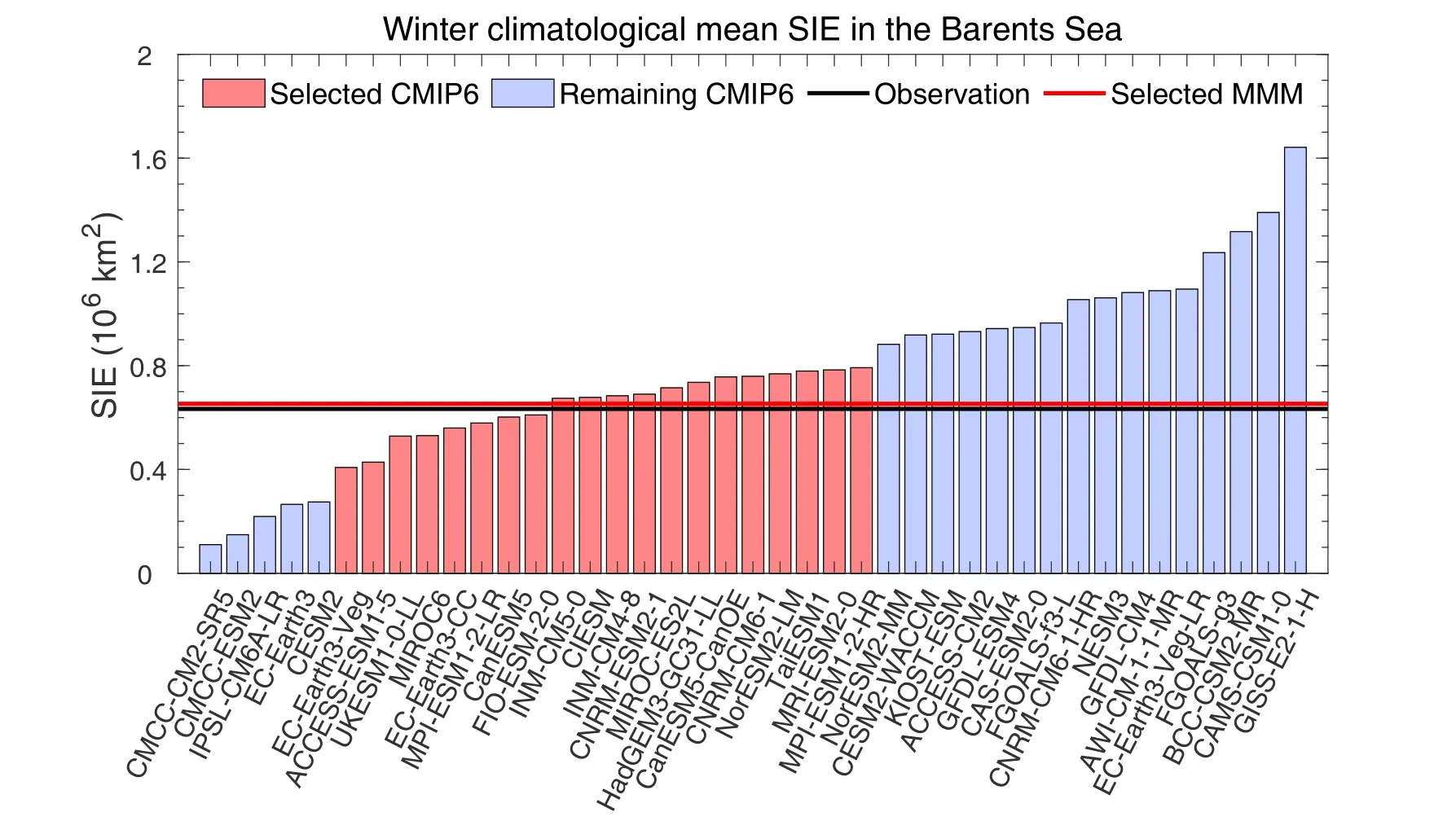
Fig.4.Winter climatological mean sea ice extent (SIE) during 1980–2014 in the Barents Sea.The black and red solid lines are the climatological winter SIE based on observations and that of the selected CMIP6 multimodel mean (MMM), respectively.
To reduce the projection uncertainty caused by the common bias of SIE overestimation, the models which well simulated the climatological SIE were selected.We chose the top 50% of models for which the simulated historical SIE was closest to the observations.The following 20 CMIP6 climate models were selected based on this criterion: ACCESSESM1-5, CanESM5, CanESM5-CanOE, CIESM, CNRMCM6-1, CNRM-ESM2-1, EC-Earth3-CC, EC-Earth3-Veg,FIO-ESM-2-0, HadGEM3-GC31-LL, INM-CM4-8, INMCM5-0, MIROC6, MIROC-ES2L, MPI-ESM1-2-HR, MPIESM1-2-LR, MRI-ESM2-0, NorESM2-LM, TaiESM1, and UKESM1-0-LL (models with red bars in Fig.4).The climatological mean winter SIE during 1980–2014 in the Barents Sea is 0.65 × 106km2in the selected multimodel mean,which is much closer to the observed value of 0.63 × 106km2(Fig.4).Figure 5 shows that the historical simulations based on the multimodel mean of these 20 selected models fit the observations much better than the result derived without model selection; that is, the common bias of SIE overestimation is reasonably small for the multimodel mean of the selected models.
Based on the projections of both the selected models and of all models, winter sea ice in the Barents Sea will continue to decrease in a warming climate (Fig.5); however,the projections without model selection produce larger discrepancies and more sea ice in the Barents Sea.The mean projections without model selection indicate that winter SIE in the Barents Sea will be 0.3 × 106and 0.1 × 106km2in 2100 under the SSP2-4.5 and SSP5-8.5 scenarios, respectively(Figs.5a, b), i.e., both larger than the ice-free criterion.The multimodel mean projections based on the selected models indicate that winter SIE in the Barents Sea will be 0.1 × 106km2in 2100 under the SSP2-4.5 scenario (Fig.5a).Under the SSP5-8.5 scenario, the Barents Sea will be ice-free in winter for the first time in 2042–2089, with a multimodel mean of 2073 (Fig.5b).
We also apply the method of emergent constraint to predict the time of occurrence of the ice-free Barents Sea based on the relationship between the climatological mean winter SIE in the Barents Sea during the historical period and the first ice-free time in the future.We found a significant positive correlation between the climatological mean winter SIE in the Barents Sea during 1980–2014 and the first-time occurrence of an ice-free Barents Sea (Fig.6).This finding suggests that models with more sea ice in the past need more heat to melt sea ice and will reach an ice-free state later in the future.Under the SSP5-8.5 scenario, 30 CMIP6 models produce an ice-free condition in the Barents Sea before the end of this century, and the best-projected first-time occurrence of an ice-free Barents Sea, based on the method of emergent constraint, is 2058.The 68% confidence level projection of the emergence constraint indicates that the first ice-free time will occur between 2042–74.Combining the projection results based on these two methods (observation-based model selection and emergent constraint), a winter ice-free Barents Sea is likely to occur for the first time during 2042–2089 under the SSP5-8.5 scenario.
3.3.SIC projections
The ratios of the CMIP6 models with winter SIC > 15%in the Barents Sea for the middle-term (2041–60) and longterm (2081–2100) projections are shown in Fig.7.Under the SSP2-4.5 scenario, projections without model selection indicate that the ratio is 10%–90% during 2041–2060 and that SIC > 15% in the northern Barents Sea is found in more than 40% of the CMIP6 models (Fig.7a).In the long-term projections, the ratio of models with winter SIC > 15% in the Barents Sea is smaller than that in the middle-term projections (Fig.7c).Figures 1b, 7a, and 7c indicate that winter SIC will decrease toward the northeastern region of the Barents Sea.However, the selected models project much less winter sea ice in the Barents Sea in the future.Projections based on the selected models indicate that winter sea ice will be mainly located in the northern Barents Sea with 10%–50%of models predicting winter SIC > 15% in the middle of the 21st century (Fig.7e).Figure 7g shows that only 30% of the selected models predict that winter sea ice will still exist in the northern Barents Sea during 2081–2100.
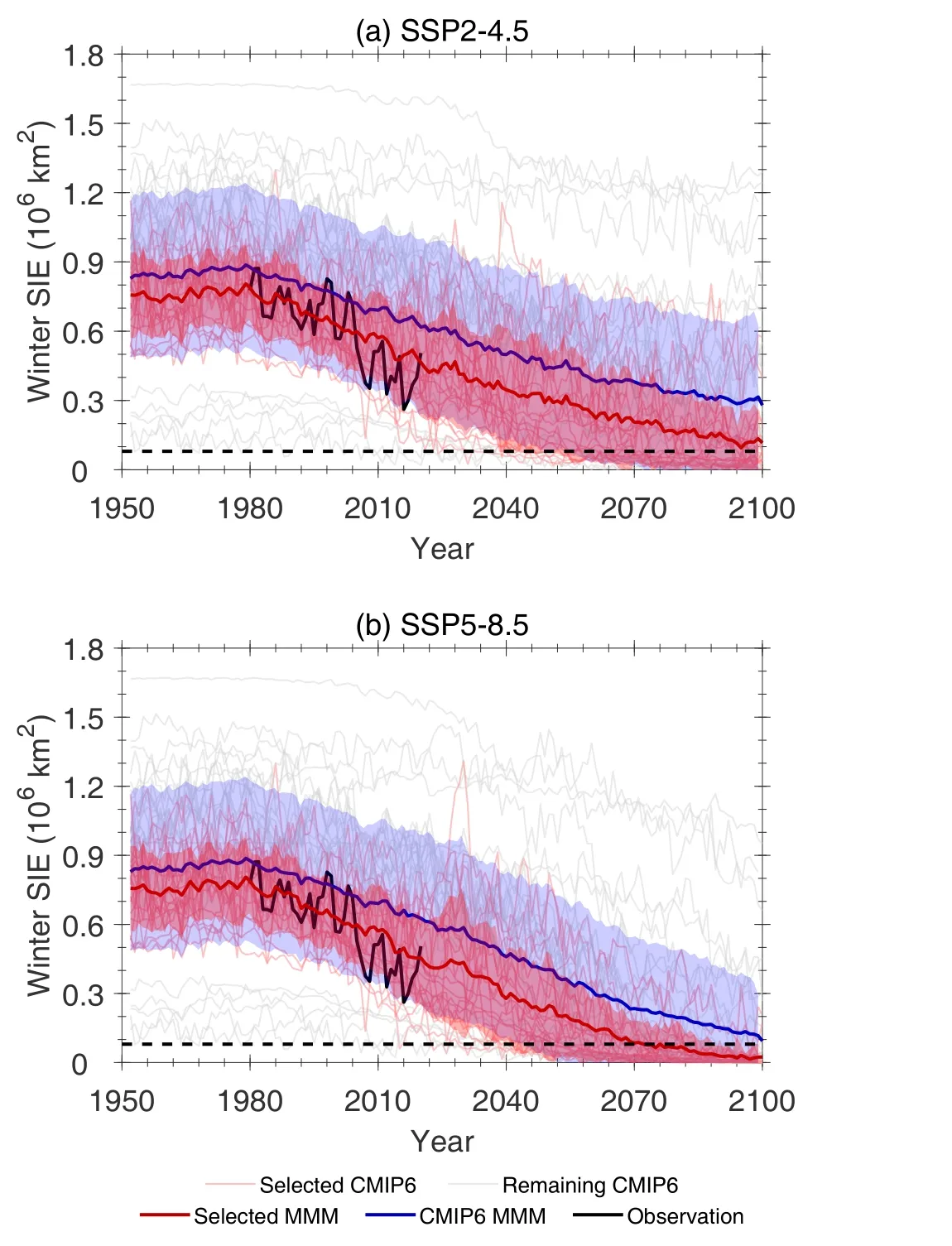
Fig.5.Time series of winter sea ice extent (SIE) in the Barents Sea.The black dotted line is the ice-free threshold (0.08 × 106 km2).The thin red line represents the 20 selected CMIP6 models, and the thin gray line represents the other CMIP6 models.The thick red line is the multimodel mean (MMM)result based on the selected models, and the thick blue line is the MMM result based on all CMIP6 models.The thick black line is the winter SIE in the Barents Sea based on observations during 1980–2020.Red and blue shadings represent one standard deviation of the selected and all climate models,respectively.
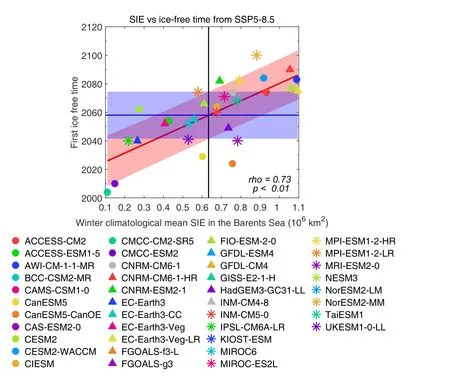
Fig.6.Relationship between the winter climatological mean sea ice extent (SIE) in the Barents Sea and the first ice-free time under the scenarios of SSP5-8.5 scenario.The red line is an ordinary least squares linear fitting line, and the red shading is the prediction error range of the linear regression (68%confidence interval).The black line is the observed winter climatological mean SIE and the blue line is the corresponding first ice-free time and its 68% confidence interval.
Under the SSP5-8.5 scenario, projections without model selection indicate that winter sea ice will mainly exist in the northern Barents Sea in the middle of the 21st century with 10%–60% of models predicting SIC > 15%, and that sea ice is predicted to remain in the northern Barents Sea in the long term in the 21st century in only 10%–20% of the models (Figs.7b, d).However, projections based on the selected models show a greater decline in winter sea ice i n the Barents Sea (Figs.7f, h), i.e., SIC in almost all the selected models is less than 15% in the entire Barents Sea during 2081–2100 (Fig.7h).
We also projected the future SIC in the Barents Sea based on the results of emergent constraint.Based on the results of the emergent constraint method under the SSP5-8.5 scenario (Fig.6), we selected the INM-CM5-0 model,
3.4.Sensitivityofwinter sea ice in the Barents Sea to globalwarming
which is the one that produces values closest to the observations and the emergent constraint result, to project the future winter SIC in the Barents Sea.The SIC projection method used here is exploratory but not the emergent constraint itself.Projections based on INM-CM5-0 show that winter sea ice in the Barents Sea will decrease from 50% of the maximum during 2041–2060 to 20% in 2081–2100 under the SSP2-4.5 scenario (Figs.8a, 8c).The INM-CM5-0 model also projects that the Barents Sea will be almost ice-free during 2081–2100 under the SSP2-4.5 scenario (Fig.8c).Under the SSP5-8.5 scenario, the INM-CM5-0 model projects that the Barents Sea will be ice-free during 2041–2060 (Fig.8b) and that the sea ice will retreat to the Arctic Ocean basin area during 2081–2100 (Fig.8d).
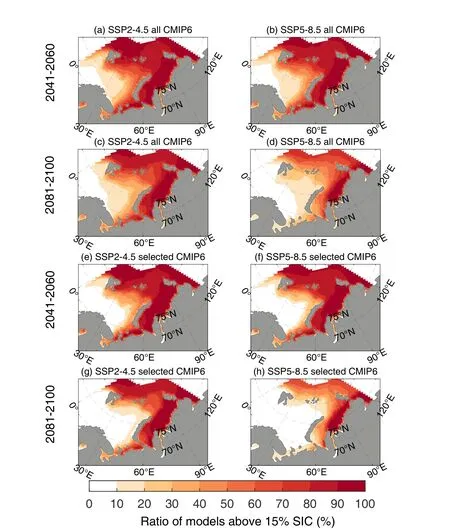
Fig.7.Ratio of CMIP6 models with sea ice concentration (SIC)> 15% of the climatological mean winter sea ice concentration(SIC) in the Barents Sea under the scenarios of SSP2-4.5 and SSP5-8.5 scenarios projected by the 20 selected models and by all the CMIP6 models during 2041–2060 and 2081–2100.
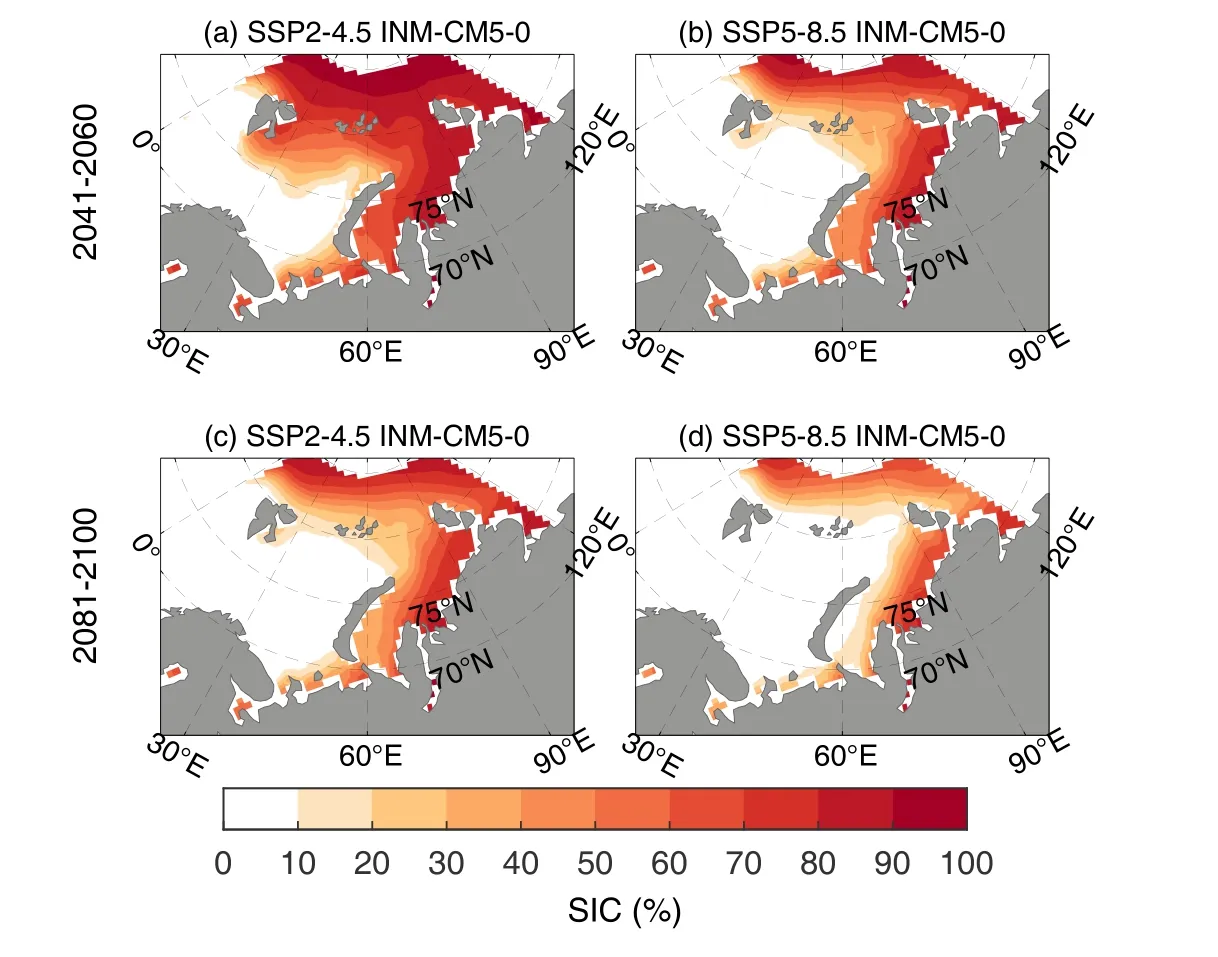
Fig.8.Climatological mean winter sea ice concentration (SIC) in the Barents Sea under the scenarios of SSP2-4.5 and SSP5-8.5 scenarios projected by the INM-CM5-0 model during 2041–2060 and 2081–2100.
To further investigate future changes in sea ice in the Barents Sea in a warming climate, the sensitivity of winter sea ice in the Barents Sea to the global mean SAT is shown in Fig.9.The results based on satellite-observed SIE and the Goddard Institute for Space Studies SAT indicate that winter SIE in the Barents Sea has decreased nearly linearly with the increase in global mean SAT.The sensitivity is-0.51 × 106km2°C–1during 1980–2014.However, the multimodel mean sensitivity of the CMIP6 models is -0.22 × 106km2°C–1during 1980–2014, which is much weaker than that based on the observations (Fig.9).Overly weak sensitivity of the CMIP6 models in terms of pan-Arctic sea ice has also been reported by Notz and SIMIP Community (2020).
The projections indicate that the sensitivity will decrease in the future under the SSP2-4.5 and SSP5-8.5 scenarios (Fig.9).Projections using the selected models indicate that a winter ice-free Barents Sea in winter will occur when the global mean SAT rises by approximately 3.5°C (relative to 1951–1980) under the SSP5-8.5 scenario.Considering the weaker sea ice sensitivity of the CMIP6 models in the historical period, the circumstance of a winter ice-free Barents Sea is likely to occur before these thresholds of global mean SAT rise are realized.
4.Discussion and conclusions
In this study, we first evaluated the simulation of winter sea ice in the Barents Sea by the latest CMIP6 models and then projected its future change.Our results showed that most CMIP6 models overestimate the climatological mean winter sea ice in the Barents Sea and underestimate the trend of sea ice decline and its sensitivity to global warming.The methods of model selection and emergent constraint were used to analyze the projections of sea ice in the Barents Sea.The projections indicated that sea ice in the Barents Sea will continue to decline in a warming climate and that a winter ice-free Barents Sea will occur for the first time during the 2042–2089 period corresponding to a rise in global mean SAT by approximately 3.5°C under the SSP5-8.5 scenario.
The large internal variability of sea ice in the Barents Sea affects model assessment and projection.We used the average of all ensembles of SIE for each model to reduce the effect of internal variability.To establish the relationship between SIE and OHT through the BSO (Fig.3b), we applied only the first ensemble of each model because of the difficulty in downloading all the ensembles of the large number of three-dimensional ocean variables used for OHT calculation.However, we believe that this had little impact on the relationship established between SIE and OHT.
Onarheim and Årthun (2017) projected winter sea ice in the Barents Sea based on four CMIP5 models, and they concluded that a winter ice-free Barents Sea will occur for the first time within 2061–2088 under the Representative Concentration Pathway 8.5 scenario, which is later than our projection of 2042–2089 based on the CMIP6 models under the SSP5-8.5 scenario.
We suggest that the main reason for the overestimation by the CMIP6 models in terms of simulated Barents Sea winter sea ice is the overly weak simulated OHT through the BSO.The OHT through the BSO is negatively correlated with winter sea ice in the Barents Sea, and an overly weak OHT in the CMIP6 models might lead to more sea ice in the Barents Sea in winter.High-resolution ocean models tend to reproduce stronger OHT and less sea ice (Docquier et al.,2019), and Table 1 indicates that the resolution of ocean models incorporated in the CMIP6 climate models remains low.The resolution of most models is nominally 1°.We used eight models with a nominal resolution of 0.25° in their ocean component models from CMIP6 HighResMIP to check the influence of model resolution (Table 2).We found that models with finer resolution can largely reduce the common biases related to the overestimation of climatological SIE and underestimation of its trend of decline(Fig.10).Thus, we suggest that improving the resolution of ocean component models could reduce the common biases of sea ice simulations in the Barents Sea.
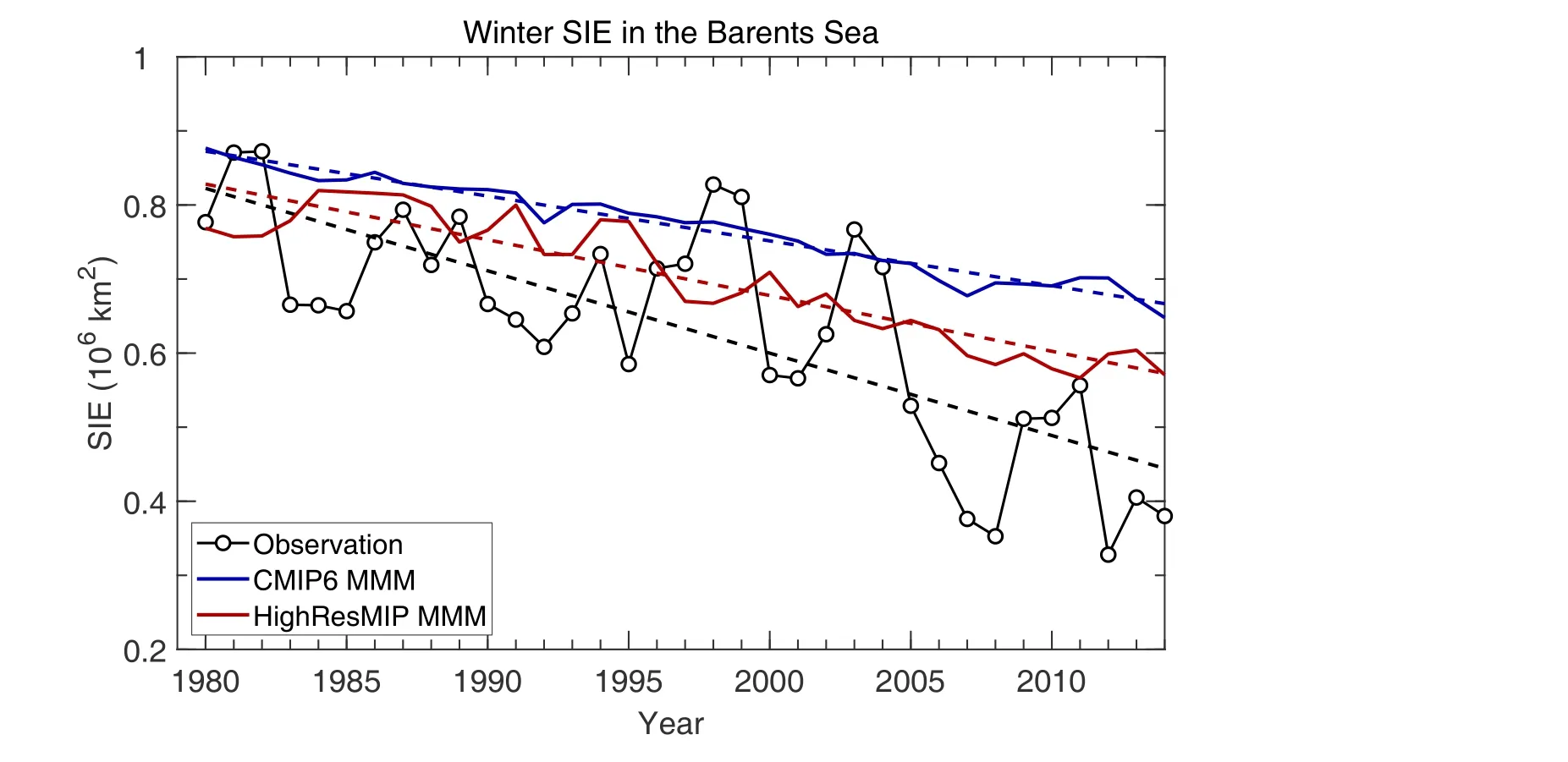
Fig.10.Time series of winter sea ice extent (SIE) in the Barents Sea during 1980–2014.The black, blue, and red dashed lines are the linear trends of the observations, CMIP6 multimodel mean (MMM) result, and HighResMIP MMM result, respectively.
AcknowledgementsThis work was supported by the Chinese Natural Science Foundation (Grant No.41941012), the Basic Scienti fic Fund for National Public Research Institute of China (ShuXingbei Young Talent Program) under contract No.2019S06, Shandong Provincial Natural Science Foundation (ZR2022JQ17), and the Taishan Scholars Program (No.tsqn202211264).The CMIP6 data were downloaded from https://esgf-node.llnl.gov/search/cmip6/.The satellite-observed SIC dataset are from NSIDC (http://nsidc.org/data/seaice/).The GISS SAT was provided by https://data.giss.nasa.gov/gistemp/graphs_v4/#.We would like to thank the above data providers.
杂志排行
Advances in Atmospheric Sciences的其它文章
- Toward Quantifying the Increasing Accessibility of the Arctic Northeast Passage in the Past Four Decades※
- Arctic Sea Level Variability from Oceanic Reanalysis and Observations※
- Separation of Atmospheric Circulation Patterns Governing Regional Variability of Arctic Sea Ice in Summer※
- The Arctic Sea Ice Thickness Change in CMIP6’s Historical Simulations※
- Evaluation of the Arctic Sea-Ice Simulation on SODA3 Datasets※
- Influence of Surface Types on the Seasonality and Inter-Model Spread of Arctic Amplification in CMIP6※
